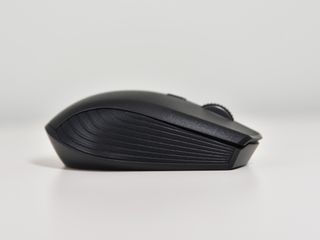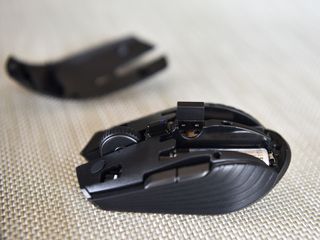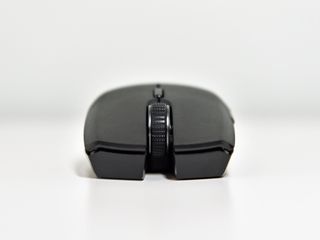Picking the right mouse for your laptop is always a challenge, especially with the sheer amount of choice consumers have these days. Razer is throwing its hat into the ring with the recently announced Atheris ($49.99), which is not only impressive but its price tag is a pro rather than a con.
What makes the Atheris impressive compared to some of the competition is the dual 2.4GHz or Bluetooth Low-Energy (LE) options and long battery life. I've been using it for the last week. Here is what you need to know.

About this review
Razer loaned us an early review unit of the Razer Atheris. Its full retail price is $49.99.
Packin' cool tech
Razer Atheris tech specs

For a travel mouse, Razer seems to get it right with the Atheris. The hardware supports Bluetooth LE for those who want to direct connect with no fuss, but there is also an included 2.4GHz wireless dongle for a higher quality connection with faster response times.
Here's a list of specs:
- 350-hour continuous use on a single pair of AA batteries (on Bluetooth mode).
- 7,200 DPI optical sensor.
- Dual connectivity.
- Built-in Bluetooth LE.
- 2.4 GHz connection with Adaptive Frequency Technology (AFT).
- Ambidextrous ergonomic form factor.
- Compact and mobile ready (dongle fits in the mouse, no extra carrying case required).
- Five independently programmable hyper-response buttons.
- Approximate size: 99.7 mm / 3.9 in (length) X 62.8 mm / 2.5 in (width) X 34.1 mm / 1.35 in (height).
- Approximate weight 66 g / 0.14 lbs (excluding batteries).
Razer uses AFT with the Atheris, and it is the same radio-optimizing technology found in the Razer Lancehead gaming mouse. Instead of just a straight 2.4GHz signal, AFT is constantly looking for open channels on the 2.4GHz spectrum to ensure there is no lag from radio interference. While interference may not be an issue at home, it can pop up on a busy public environment like a coffee shop or airport where many devices are competing for a signal.
Keepin' it simple
Razer Atheris design
Compared to the Razer Lancehead, there is a clear design aesthetic that is being carried over to the Atheris. But there are some differences, too. Both mice share rubber sides for extra grip, the same split-center design, and similar button placement.
Where the Atheris differs from the Lancehead is it does not have two extra buttons on the right side, making this mouse slightly less ambidextrous for left-handers.

Being a travel mouse, there is also no RGB Chroma lighting found in the Atheris, which would zap the battery very quickly.
The Atheris is jet black with no color variations, save for a tiny LED at the top that shifts between blue or green depending on the function state. It's a surprisingly minimal design coming from Razer that's aimed more at professionals than teenage gamers.
At 66 grams, the mouse feels dense for its size, which is a good thing for those who don't like hollow-feeling mice.
There are two features that when compared to the similar Logitech MX Anywhere 2 stand out:
- There is a hidden travel compartment for the 2.4GHz dongle.
- The scroll wheel can operate as a third button (programmable).
The first feature is essential if you don't want to lose the tiny 2.4GHz dongle. The back of the Atheris simply peels off as it is held on by strong magnets. You wouldn't know it's there unless someone told you. The dongle just slides into a small slot and required no effort to remove. The same design also allows you to swap the two AA batteries (included).

While not everyone uses a scroll wheel to click as a button, many do, and it's good to see it here. By default, in Windows 10, the scroll-click opens a web link in a new tab in the background, which is perfect for those of us who multitask. Of course, you can reassign the button to anything you want through the Razer Synapse 3 software.
The two left side buttons are set for forward and backward web browsing, but again, they can be assigned to any function. The buttons are easy to feel for without looking and have a satisfying soft-click. But they are thinner than I would like.

For size, the Atheris is compact, at about three-quarters the size of the Razer Lancehead or any full desktop mouse. It is rounded enough, however, to reach your palm, but it's not nearly as flat or curvy as the Surface Arc Mouse.
Finally, behind the scroll wheel sits another small button. By default, this shifts between DPI settings, which range from 200 to 7,200. There are five user-configurable DPI presets for sensitivity, and clicking the button changes them. You don't need the Razer Synapse software to do this, but when installed it pops up a window informing you of the change and the setting. Even better, those presets can be customized with high specificity.
Saving power or performance
Choosing between 2.4GHz or Bluetooth
Razer gives users a choice between using Bluetooth or a 2.4GHz connection on the Atheris, with the latter featuring the previously mentioned AFT for signal superiority.
There's a substantial difference between Bluetooth and 2.4GHz AFT too, which comes down to one feature: polling rate. With Bluetooth, the only rate at which the Atheris's optical sensor hits is 250 Hz. Switch over to 2.4GHz AFT, and 500 Hz and 1000 Hz (one millisecond) are now on the table.


Of course, using the Atheris at one millisecond response time will reduce the battery life, but for those who suddenly want to play a quick game, it's a great option. Even at 500 Hz polling, there is a significant difference versus the "feel" of a Bluetooth connection at just 250 Hz making the dongle-solution substantially better. For most users, the 500 Hz polling rate will be OK for regular productivity usage.


There is no reason to choose, however, between the competing technologies. A user can pair the Atheris via Bluetooth or use the 2.4GHz dongle on the same computer. By using the switch on the bottom of the Atheris, you switch between the modes giving a lot of flexibility. If you are using the Atheris with the Surface Pro and suddenly need its one USB port, you can just flip over to Bluetooth, and you're all set.


Since the 2.4Ghz dongle is always with the Atheris, it makes carrying it around and switching a breeze. While I'm not a huge fan of having to sacrifice a USB port for a dongle, at least the one Razer includes is very compact, fits into the Atheris itself, and is entirely optional.
Puttin' it to the test
Razer Atheris usage
In using the Atheris, I had no major complaints. The right and left buttons have very nice clicks, with a slight difference in sound.
The scroll wheel is not quite as aggressive for clicks as Logitech mice, but it can be felt when scrolling. There is no "free scroll" option either, but you can use it as a third-button. The scroll wheel though has a slight play before it "clicks" with a minor rattle as if it is a bit loose, which can get annoying in a quiet room.

The overall design is ambidextrous – that is if you split it in the middle, it's essentially the same on both sides save for the side buttons. Being a travel mouse, you are sacrificing a bit since the Atheris is small, but it was never uncomfortable like a Microsoft Wedge mouse or the Logitech Ultrathin Touch Mouse.
Pairing via Bluetooth or 2.4 GHz dongle was never an issue. However, Razer's still-in-beta Synapse 3 software did not like it when the Atheris was in Bluetooth mode, often crashing on multiple computers. Considering Synapse 3 officially does not support Atheris just yet I'll chalk that up to its beta status.
Update: 9/13/18 - Razer has now pushed an update that fixes the Bluetooth crashing noted above.
Razer says that the Atheris supports 350 hours of continuous use with the included, non-rechargeable AA batteries. That's nearly 15 days straight. If you use the Atheris for four hours a day, every day, you should be able to go close to three months before having to change the batteries.

The catch, of course, is that's while utilizing Bluetooth LE and not the more power-hungry 2.4GHz one. Even then, it can vary depending on if you use 250 Hz, 500 Hz or 1000 Hz polling. Still, over a few days even on the 2.4 GHz, I didn't see the Atheris lose much battery, suggesting it should last a few weeks at minimum.
Unfortunately, the Atheris does not have any micro USB connection for a wired setup, and if you run out of batteries while on the road there is no backup.
In conclusion ...
Razer Atheris is a great buy
In using the Razer Atheris, there were no deal-killers for me. Everything worked as it should, the mouse was comfortable to use, and I appreciated the options for button programming and wireless technology.
The buttons and scroll wheel were excellent, and the ability to use 500 Hz or 1,000 Hz polling is great.

While 7,200 DPI is too high for many computers, I'm fine using it with the Surface Studio or any display that is 4K or greater. For those with full HD displays (1080 x 1920) using 2,400 or 3,600 DPI is just fine. Again, being able to dynamically switch between DPI settings with a click of a button is super convenient especially when switching computers. Moreover, Razer Synapse 3 lets you carry over user profiles for the Atheris through the cloud to any PC you connect it to.
The real selling point for the Razer Atheris is price. At $49.99, it's the same as Logitech's similar MX Anywhere 2, but it offers a storage compartment for its dongle, and the scroll wheel acts as a third button. Those are significant differences, and it speaks in favor of the Atheris. What it lacks, however, is multiple-pairing buttons for Bluetooth, which is a bit of a shame.

For those looking for a reliable travel mouse with an excellent signal, high sensitivity and accuracy, the Razer Atheris should be on your short list of considerations.
Pros:
- High DPI and polling settings.
- Easily switch between Bluetooth or 2.4 GHz AFT.
- Storage compartment for 2.4 GHz dongle.
- Comfortable to use with good battery life.
- Affordable.
Cons:
- No wired option if batteries die.
- No multiple-pairing button for Bluetooth.
- Slight rattle with the scroll wheel.

Daniel Rubino is the Editor-in-chief of Windows Central. He is also the head reviewer, podcast co-host, and analyst. He has been covering Microsoft since 2007, when this site was called WMExperts (and later Windows Phone Central). His interests include Windows, laptops, next-gen computing, and watches. He has been reviewing laptops since 2015 and is particularly fond of 2-in-1 convertibles, ARM processors, new form factors, and thin-and-light PCs. Before all this tech stuff, he worked on a Ph.D. in linguistics, watched people sleep (for medical purposes!), and ran the projectors at movie theaters because it was fun.
